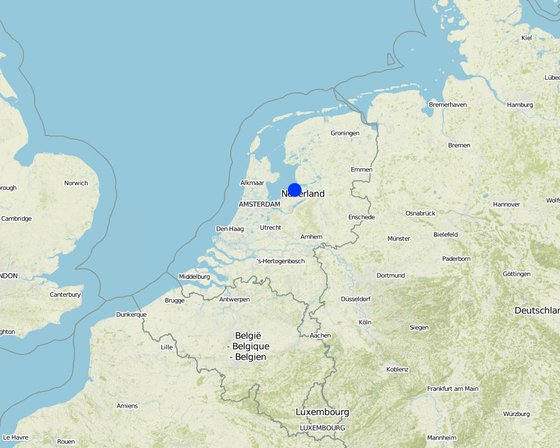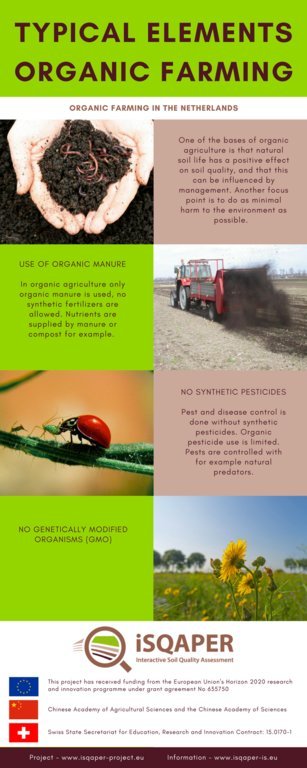

The technology is in this specific case applied on sandy loam soils in the Netherlands. It is not limited to those specific conditions. Organic agriculture could as well be applied on other soil types, and it could be applied in various cropping systems as well. There are no environmental limitations known which would prevent a farmer from applying certified organic agriculture on his farm fields.
The characteristics which a system has to fulfill to be certified organic agriculture are to be found in the standards for organic production in the EU (Council Regulation (EC) No 834/2007). Main points in this standard are: no application of synthetic pesticides and no use of synthetic fertilizer. Next to that, there are certain specifications on how many crops you need to have as a minimum in your rotation etc. The purpose of this technology is a sustainable production in general. The idea behind is, that with more care and attention for your production, without the use of synthetic products, you will have a more sustainable and resilient system.
The major input in organic agriculture is organic manure. Because synthetic fertilizers are not allowed more care and attention is paid to apply the right amount of the right organic fertilizers. In general this leads to higher inputs of organic matter to the soil.
The positive impacts of organic agriculture are:
- better general soil quality (more organic matter, better structure, higher fertility, more soil life, more diverse soil life)
- better water holding capacity
- reduced nitrate leaching to the groundwater
- good economic impact (with the label 'organic' farmers can sell their products for a higher price)
Organic agriculture (compared to conventional) also has a negative impact: yields are in general up to 20% lower than conventional production. This yield reduction is mainly caused by pests and diseases, because no synthetic pesticides are allowed, the control of many diseases and pests is not possible.
Land users like this technique because it is actually more than just an application of a technique, it is a way of farming. Organic farming calls upon the craftmanship of the farmers. They like it because they know they are contributing to a more sustainable farming system. Farmers may dislike it because it is complicated to obtain the same yields as with conventional agriculture, and because it is not yet possible to control all pests and diseases.

ទីតាំង: Surroundings of Lelystad, Flevoland - Flevopolder, ប្រទេសហូឡង់
ចំនួនទីកន្លែងបច្ចេកទេស ដែលវិភាគ: មួយកន្លែង
ការសាយភាយនៃបច្ចេកទេស: ត្រូវបានផ្សព្វផ្សាយត្រឹមតំបន់មួយ (approx. 0.1-1 គម2)
តើស្ថិតក្នុងតំបន់ការពារអចិន្ត្រៃយ៍?:
កាលបរិច្ឆេទនៃការអនុវត្ត: 2009
ប្រភេទនៃការណែនាំឱ្យអនុវត្តន៍៖









| បញ្ជាក់ពីធាតុចូល | ឯកតា | បរិមាណ | ថ្លៃដើមក្នុងមួយឯកតា (euro) | ថ្លៃធាតុចូលសរុប (euro) | % នៃថ្លៃដើមដែលចំណាយដោយអ្នកប្រើប្រាស់ដី |
| សម្ភារៈ | |||||
| Investment in mechanical weed control machine | piece | 1,0 | 5000,0 | 5000,0 | 100,0 |
| ថ្លៃដើមសរុបក្នុងការបង្កើតបច្ចេកទេស | 5'000.0 | ||||
| ថ្លៃដើមសរុបក្នុងការបង្កើតបច្ចេកទេសគិតជាដុល្លារ | 5'747.13 | ||||
| បញ្ជាក់ពីធាតុចូល | ឯកតា | បរិមាណ | ថ្លៃដើមក្នុងមួយឯកតា (euro) | ថ្លៃធាតុចូលសរុប (euro) | % នៃថ្លៃដើមដែលចំណាយដោយអ្នកប្រើប្រាស់ដី |
| កម្លាំងពលកម្ម | |||||
| Additional handlabour mostly for weeding | hours | 250,0 | 160,0 | 40000,0 | 100,0 |
| Additional labour for mechanical weed control | hours | 75,0 | 160,0 | 12000,0 | 100,0 |
| សម្ភារៈ | |||||
| Yearly costs of weed control mechanization | euro | 1,0 | 5000,0 | 5000,0 | 100,0 |
| ថ្លៃដើមសរុបសម្រាប់ការថែទាំដំណាំតាមបច្ចេកទេស | 57'000.0 | ||||
| ថ្លៃដើមសរុបសម្រាប់ការថែទាំដំណាំតាមបច្ចេកទេសគិតជាដុល្លារ | 65'517.24 | ||||
Crop yields in organic agriculture are up to 20% lower compared to conventional
Organic planting material is more expensive than conventional
Per product organic farmers will get a higher price
The use of (hand)weeding increases because of no herbicide use
Due to better soil structure runoff is limited, therefor the water holding capacity and natural drainage of the soil improves.
Due to higher organic matter (manure) inputs the water holding capacity of the soil improves.
In general, soils used in organic agriculture are covered during more months within a year, due to more usage of cover crops in winter season for example
More attention is paid to the nutrientcycles, cover crops are used to maintain nutrients for the next season
More organic matter is applied, slowly this will lead to a higher content in the soil
No use of pesticides gives the opportunity for a diverse range of plants to develop
Pesticides can also harm the beneficial species, no pesticides = more benificial species
The whole agricultural system gets more diverse due to more organic inputs and less pesticide inputs
It is harder to control pests and diseases, when synthetic pesticides are not allowed. There is no organic cure for all pests and diseases (yet)
With organic agriculture there is less nitrate leaching